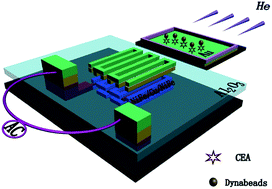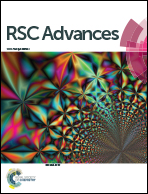Ultrasensitive determination of carcinoembryonic antigens using a magnetoimpedance immunosensor
Abstract
Herein, a giant magnetoimpedance (GMI) sensor combined with the sandwich immunoassay was used for ultrasensitive detection of carcinoembryonic antigens (CEA). Oblong-shaped Au films were enclosed with SU-8 photoresists to form several microcavities that were treated with different concentrations of CEA. The quantification of low-concentration CEA (1 pg mL−1–10 ng mL−1) was achieved by using one single GMI sensor, demonstrating a good linear relationship between the GMI response and the CEA concentration. The lower detection limit for CEA was found to be as low as 1 pg mL−1, which provides extreme sensitivity. We observed that high-concentration CEA (>10 ng mL−1) can result in a cluster of Dynabeads, thereby reducing the target signals since the adjacent magnetic dipole fields canceled each other out. Target specificity of the GMI-based magnetic immunoassay has also been verified by testing nonspecific targets. The results obtained here suggest that the GMI sensor could serve as an ultrasensitive immunosensor for quantitative determination of biomarkers.


 Please wait while we load your content...
Please wait while we load your content...